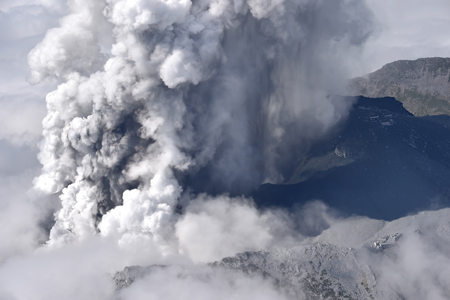Beware the simmering volcano that goes quiet, scientists report.
For example, before the Telica Volcano in León, Nicaragua, exploded, seismic activity abated for a long period of quiescence, according to results published in Earth and Planetary Science Letters on 23 June. Nearly a dozen anecdotal reports have noted the same phenomenon at volcanoes worldwide, but the current findings are the first to quantify the duration and number of quiet periods to forecast explosions.
If the observations can be applied to other volcanoes, hikers and residents will be better protected from gaseous explosions that sometimes occur with little warning, the researchers note.
The Calm Before the Storm
“We initially noticed that Telica got seismically quiet before it exploded during the 2011 eruption when we were watching the real-time data come in,” says geologist Diana Roman, lead author of the study. At the time, Roman was packing her office at the University of South Florida for a move to Washington, D. C, where she currently studies volcanoes on faculty at the Carnegie Institution of Science.
“It was a really hectic time—I kept running over to my computer to pull the seismic information on the internet. The patterns were observed during the first week, but we had to do more analysis to really convince ourselves,” she said.
As May came to a close and the monthlong series of explosions drew to an end, Roman and her colleagues set out to analyze the seismic data in detail. It was no surprise that activity increased before and during the eruption, but researchers also observed moments of calm right before the explosions when seismic waves flatlined.
The team observed a series of 50 explosions, and all but two were preceded by a quiet period. Of the calm episodes, 35 lasted for more than 30 minutes, but these were variable in duration. One calm event lasted for nearly 10 hours, whereas many others fell just under an hour. Thirteen other explosions were preceded by shorter intervals that lasted 5 to 30 minutes.
Using the Quiet to Predict Explosions
Next, the team set out to quantify the energy released by each explosion. Known mathematical relationships relate seismic signals during an eruption event to the amount of energy released. This helped Roman and her colleagues scale the length of the quiet periods to the severity of explosions.
It turns out that longer calm periods at Telica signaled a greater eruption event. Quiet periods of 5 to 30 minutes forecast the smallest explosions. In contrast, a large volume of ash was released following the 10-hour period of calm, causing the Volcanic Ash Advisory Center in Washington, D. C., to publish a warning for aircraft.
Following other lengthy periods of quiescence, hot rocks were thrown from the volcano, starting fires in the surrounding landscape. By building a model from the empirical results, researchers were able to accurately predict the minimum energy of the explosions from the length of preceding quiescence.
A Worldwide Phenomenon?
Studies of other volcanoes have noted occasional quiet events, but no systematic study of quiescence has been previously published. However, when Roman began presenting preliminary findings at conferences, other scientists contacted her with similar observations.
“We have collected nearly a dozen anecdotal examples from volcanoes worldwide, and this same phenomenon can definitely be seen,” says Roman. She also cautions, however, that more research is needed—at least two of the cases her team investigated did not demonstrate a clear pattern.
It may be that open-vent volcanoes and those with well-developed hydrothermal systems are more prone to the pattern, says Roman. This is because the relationship between the size of the explosion and the length of the quiet period may be due to the blockage of gas pathways beneath the volcano, where mineral precipitation seals cracks and where rocks settle near the surface between explosions.
Thus, the longer the duration between eruptions is, the more gas builds up to overpressurize the system, and the more explosive the next eruption will be.
“There has been a qualitative view up to now that these kinds of eruptions are caused by some kind of hydrothermal sealing of gas pathways, leading to the buildup of overpressure in either the conduit or hydrothermal system, which eventually leads to a small eruption,” says Marie Edmonds, a volcanologist from the University of Cambridge in the United Kingdom. “This paper is the first to quantitatively show that these eruptions are indeed preceded by quiet periods seismically, which is consistent with the idea of sealing and stagnation of fluid flow prior to eruption.” Edmonds made no contributions to the current research.

Phreatic eruptions, which are caused by steam pressure rather than magmatic heat and are less well understood, can be unpredictable and can claim lives. No deaths occurred because of the documented explosions at Telica, but a similar eruption that surprised hikers at Mount Ontake on 27 September 2014 killed more than 50 people.
The current findings “bring us ever closer to being able to forecast eruptions precisely,” said Edmonds. However, a database of observations from other phreatic volcanoes is needed to compare different eruption sizes, durations of quiescence, fluid flux, and scaling relationships, she added.
—Amy Coombs, Editorial Intern
Editor’s Note: The photograph above, of a deadly eruption of Japan’s Mount Ontake on 27 September 2014, replaces a previous image that appeared with this article and showed volcanic ash billowing near a man and a building on the mountain that same day.
